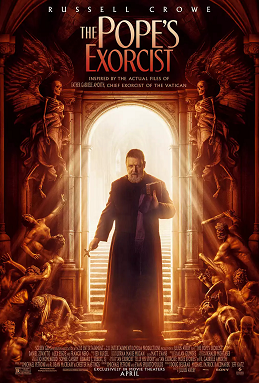It’s too bad The Pope’s Exorcist didn’t come out before Nightmares with the Bible. In that book I tried to make the connection between demons and nightmares and in this movie Asmodeus, the “named demon” gives his name as “Nightmare.” Released in April of this year, The Pope’s Exorcist received a considerable amount of fanfare. Starring Russell Crowe as Fr. Gabriele Amorth (two of whose books I’ve posted on), the entirely fictionalized account ends up coming across as, I shudder to say it, rather silly. Using just about every exorcism movie trope available, the film goes over the top and really doesn’t have much scare in it. Let’s start from the beginning. Fr. Amorth is in trouble at the Vatican but the Pope’s his personal friend, so no worries there. Meanwhile an American woman has inherited a decrepit abbey in Castille, Spain. Her late husband owned nothing else and she has to be there personally to oversee restoration, dragging her two kids with her.

It turns out that this abbey contains evidence of a centuries’ old conspiracy during the Spanish Inquisition covered up by the Vatican. It’s also the home of Asmodeus, king of Hell. And one of 200 locations that fallen angels came to earth. After the demon scorches a couple of restoration workers, the woman, Julia, is left in the spooky abbey alone with her kids. They both end up possessed, but the boy, Henry, is the focus of the body horror. Since Asmodeus has clearly seen The Exorcist, he says outright that he’s after Fr. Amorth, who is sent by the Pope himself to take care of this. To save the boy Amorth has to be possessed in his stead (as in The Exorcist). Together with a younger priest (really, is any of this sounding familiar?), the demon eventually has to capitulate.
Apart from not being “based on a true story,” the movie also takes seriously the fictionalization of characters. “The Pope,” never named, in the 1980s was John Paul II. He’s portrayed as bearded and in poor health. Amorth (Crowe) is also bearded, although historically Amorth, like most Roman priests, was clean-shaven. The “silliness” of the movie derives from not having researched Roman Catholicism thoroughly. All of this makes me wonder if an exorcism movie can be made that surpasses The Exorcist. Much has been written on that movie since William Friedkin recently died (and much was written on it before). It’s difficult to put a finger on just what made that film so superior. It doesn’t stop others from trying, of course. And now there’s talk of a sequel for The Pope’s Exorcist. The nightmares, it seems, never end.
